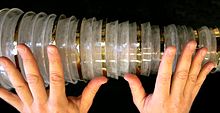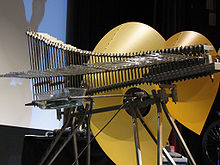This article relies largely or entirely on a single source. (April 2021) |



A crystallophone is a musical instrument that produces sound from glass.
One of the best known crystallophones is the glass harmonica, a set of rotating glass bowls which produce eerie, clear tones when rubbed with a wet finger. Musical glasses, the glass harp, were documented in Persia in the 14th century.[1] The "ethereal" quality of instruments such as the glass harmonica exemplified the Empfindsamkeit and for a while, "the instrument was extraordinarily popular...[but] About 1830 the instrument fell into oblivion."[1]
The glasschord (or glasscord) resembles the celesta (a struck plaque idiophone operated by a keyboard) but uses keyboard-driven hammers to strike glass bars instead of metal bars.
The glass marimba is similar to the marimba (a stick percussion instrument with a keyboard layout), but has bars of glass instead of wood. The bars, which the performer strikes with padded sticks, are perched on a glass box to provide the necessary resonance.
A rare Thai instrument called ranat kaeo (ระนาดแก้ว; literally "glass xylophone") has been used by the Thai music ensemble Fong Naam; it appears on their 1992 CD The Sleeping Angel: Thai Classical Music.
- ^ a b Apel, Willi (1969). Harvard Dictionary of Music, p.347. Harvard. ISBN 9780674375017.